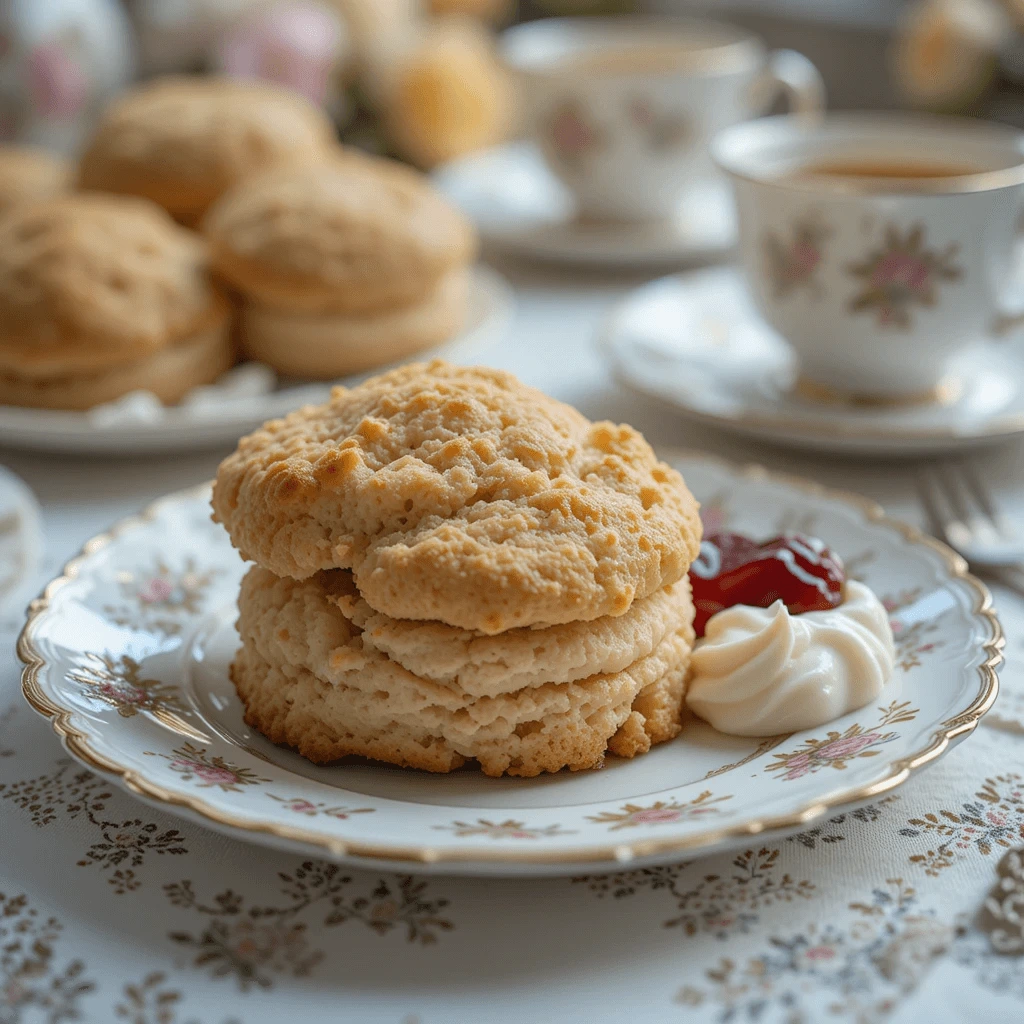Afternoon tea is one of the most cherished traditions, and no afternoon tea is complete without the quintessential scone. Whether you’re hosting a formal tea party, enjoying a casual gathering, or simply indulging in a quiet afternoon, scones are a must. This ultimate guide will walk you through everything you need to know about afternoon tea scones: how to make them, what to serve with them, how to eat them, and much more. Plus, you’ll find tables and tips to help you perfect your scone experience.
Print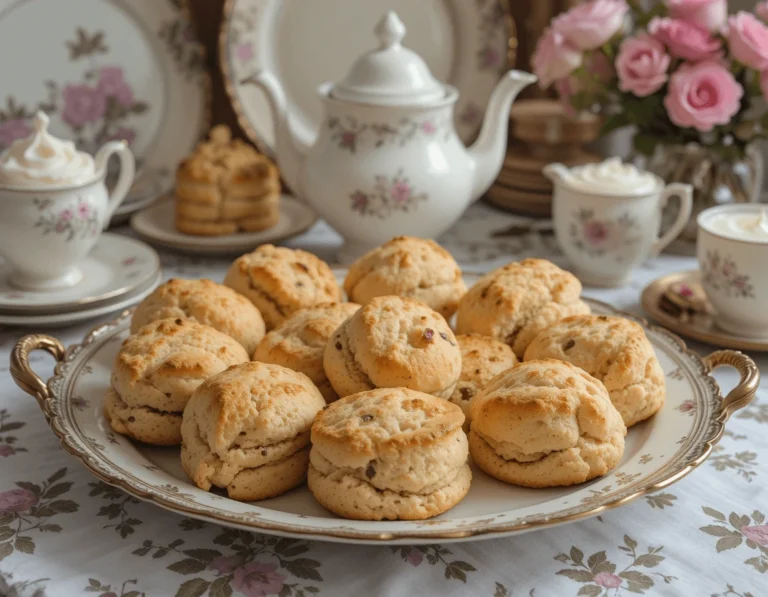
Afternoon Tea Scones: The Ultimate Guide to Making, Serving, and Enjoying Them
Afternoon Tea Scones are the perfect treat to accompany your tea. These light and fluffy scones are made with simple ingredients like flour, butter, and sugar, and they are traditionally served with clotted cream and jam. Whether you’re hosting a formal tea party or enjoying a quiet afternoon at home, these scones will elevate your tea experience.
- Total Time: 27-30 minutes
- Yield: 8 scones (depending on size) 1x
Ingredients
2 cups all-purpose flour
1/4 cup granulated sugar
1 tablespoon baking powder
1/2 teaspoon salt
1/2 cup unsalted butter, cold and cubed
2/3 cup whole milk (or any milk alternative)
1 teaspoon vanilla extract
1 egg (for egg wash)
Optional: 1/2 cup raisins, currants, or dried fruit (for fruit scones)
Instructions
Preheat the oven to 400°F (200°C) and line a baking sheet with parchment paper.
Mix Dry Ingredients: In a large bowl, whisk together flour, sugar, baking powder, and salt.
Cut in Butter: Add the cold cubed butter to the flour mixture. Use a pastry cutter or your fingers to work the butter into the flour until the mixture resembles coarse crumbs.
Add Wet Ingredients: Pour in the milk and vanilla extract. Stir gently until the dough begins to come together. If making fruit scones, fold in raisins or dried fruit at this stage.
Shape the Dough: Turn the dough out onto a lightly floured surface and gently knead it 3-4 times. Pat the dough into a round about 1-inch thick.
Cut the Scones: Using a round biscuit cutter, cut out scones and place them on the prepared baking sheet.
Brush with Egg Wash: Beat the egg and brush it over the top of each scone to give them a golden finish when baked.
Bake for 12-15 minutes, or until the scones are golden brown on top.
Serve warm with clotted cream and jam of your choice.
Notes
Make sure to use cold butter to get the light, flaky texture that is characteristic of scones.
For a dairy-free version, substitute butter with coconut oil and use non-dairy milk like almond or oat milk.
These scones are best served fresh but can be stored in an airtight container for up to 2-3 days.
- Prep Time: 15 minutes
- Cook Time: 12-15 minutes
- Category: Dessert
- Method: Baking
- Cuisine: British
- Diet: Vegetarian
Nutrition
- Serving Size: 1 scone
- Calories: 250 kcal (approximate)
- Sugar: 5g
- Sodium: 200mg
- Fat: 15g
- Saturated Fat: 8g
- Unsaturated Fat: 6g
- Trans Fat: 0g
- Carbohydrates: 27g
- Fiber: 1g
- Protein: 3g
- Cholesterol: 40mg
Keywords: Afternoon Tea Scones, scone recipe, tea party treats, traditional scones, clotted cream scones, easy scones recipe, fruit scones, tea time scones
Introduction to Afternoon Tea Scones
What Makes Afternoon Tea Scones So Special?
Afternoon tea scones are a symbol of tradition, elegance, and deliciousness. These slightly sweet, buttery pastries are best enjoyed fresh and warm, often with jam and clotted cream. But what exactly makes them so special? In this section, we’ll explore their history and their significance to the afternoon tea tradition.
A Brief History of Scones and Afternoon Tea
The tradition of afternoon tea was established by Anna, the Duchess of Bedford, in the early 19th century. It was a way to bridge the gap between lunch and dinner. Scones, with their simple ingredients and versatility, became a popular accompaniment to this mid-afternoon indulgence.
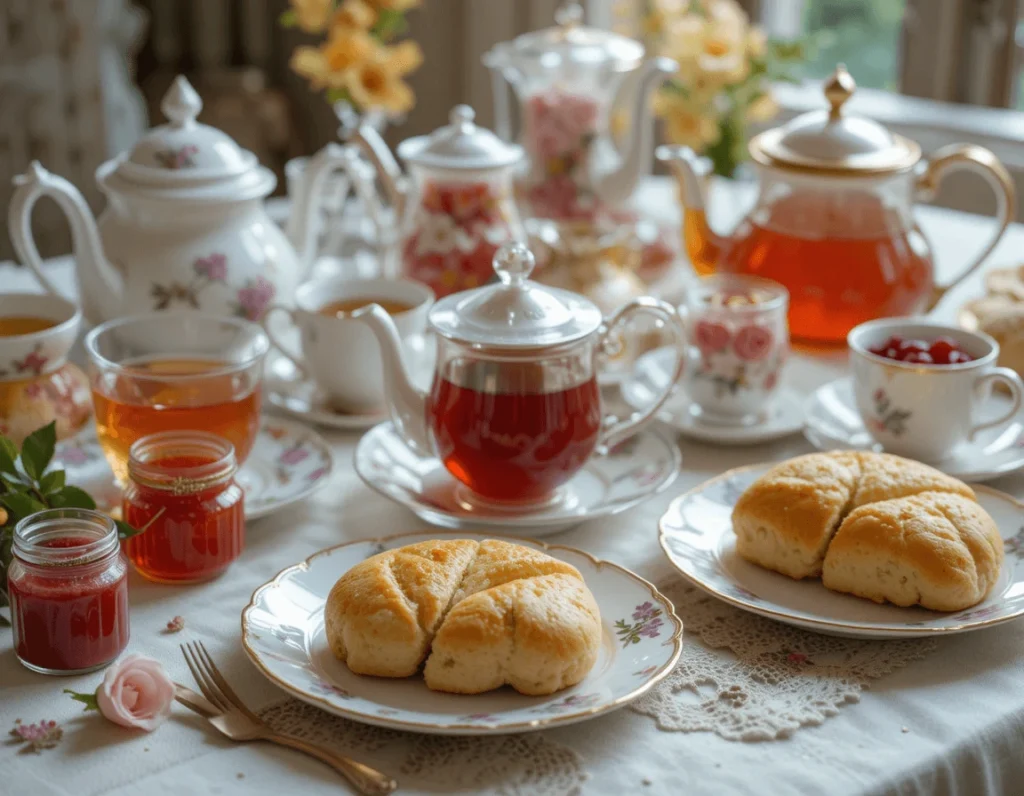
Table of Contents
Table of Contents
What to Serve with Scones for Afternoon Tea
Tea Pairings for Afternoon Tea Scones
A cup of tea is almost always paired with your afternoon tea scones. But not just any tea will do! The tea should complement the flavors of the scones, whether you choose a sweet or savory scone. Here are some tea pairings to consider:
| Tea Type | Flavor Profile | Best Scone Pairing |
|---|---|---|
| Earl Grey | Floral and citrusy | Classic scones with clotted cream and jam |
| English Breakfast | Robust and malty | Savory scones with cheddar or smoked salmon |
| Darjeeling | Light and musky | Fruit scones or lighter, sweet scones |
| Chamomile | Mild and calming | Light, fruit-filled scones |
Best Jam Pairings for Your Scones:
| Jam Flavor | Ideal Pairing with Scones |
|---|---|
| Strawberry | Works perfectly with traditional scones |
| Raspberry | Great with fruit scones or plain scones |
| Apricot | Adds a tart twist to cheese scones |
Sweet and Savory Accompaniments for Scones
In addition to cream and jam, you can offer a variety of other sides to complement your scones. Here’s a selection of popular accompaniments:
| Savory Accompaniments | Sweet Accompaniments |
|---|---|
| Cucumber sandwiches | Fresh berries |
| Cheese scones with chutney | Honey or lemon curd |
| Smoked salmon | Clotted cream |
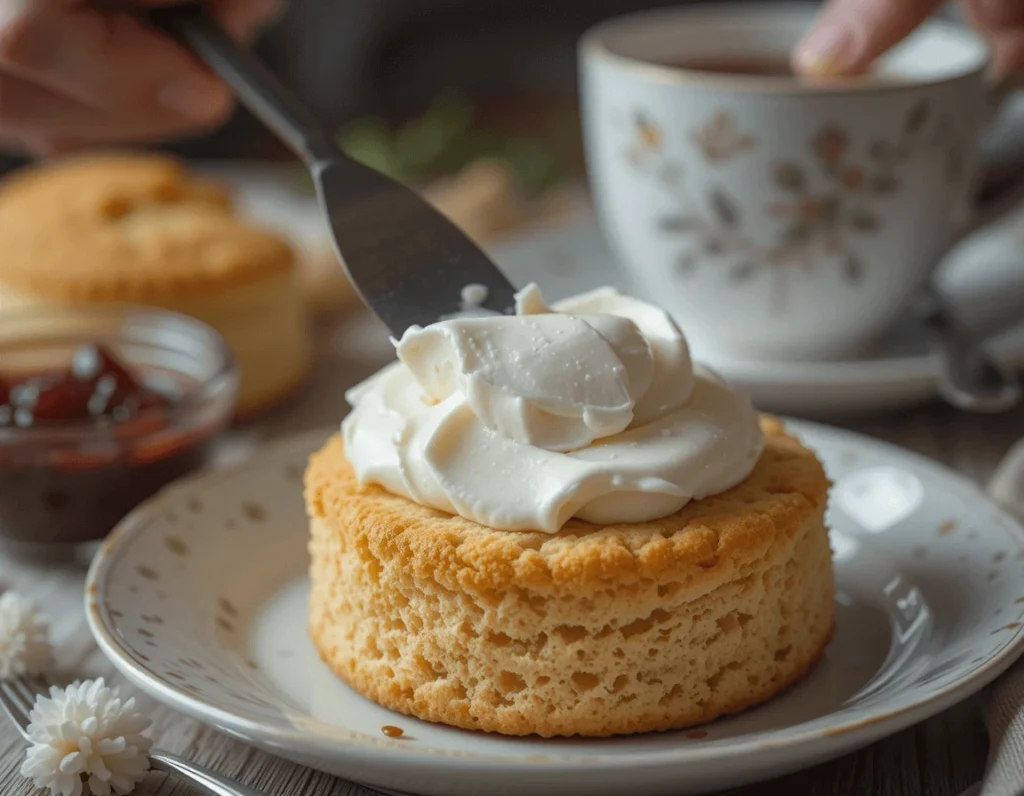
What Cream Do You Put on Scones for Afternoon Tea?
One of the most delightful aspects of afternoon tea scones is the variety of creams that can accompany them. The right cream can elevate the flavor of your afternoon tea scones, making them even more indulgent. Whether you’re sticking with tradition or experimenting with new textures, the cream you choose plays a crucial role in enhancing the scone experience. In this section, we’ll explore the different types of cream commonly used for afternoon tea scones, as well as some alternatives for those with dietary preferences.
The Importance of Clotted Cream
When it comes to afternoon tea scones, clotted cream is the classic and most traditional choice. Originating from the West Country of England, particularly Devon and Cornwall, clotted cream is made by slowly heating full-fat milk until the cream rises to the surface and forms “clots.” The result is a thick, rich, and velvety cream that has a naturally sweet taste and a luxurious texture, making it the ideal complement to afternoon tea scones.
Why clotted cream?
- Rich and Velvety: Clotted cream is thick and smooth, which means it doesn’t melt immediately when spread onto a warm scone. It holds its shape and adds a decadently creamy layer to your afternoon tea scone.
- Mildly Sweet: Unlike whipped cream, which has a more neutral flavor, clotted cream has a natural sweetness that pairs perfectly with both fruit jams and savory scones.
- Traditional Choice: If you’re looking for an authentic afternoon tea scone experience, clotted cream is the way to go. Its historical connection to English tea culture makes it a key component of the tradition.
How to Serve Clotted Cream:
- Always serve clotted cream at room temperature for easy spreading.
- It’s best paired with sweet jams, such as strawberry, raspberry, or apricot, to complement its rich, slightly sweet flavor when enjoying your afternoon tea scones.
Alternatives to Clotted Cream
While clotted cream is the most traditional option, it’s not the only choice for topping your scones. Depending on dietary restrictions or personal preferences, here are some great alternatives to clotted cream:
Whipped Cream
For those who prefer a lighter option, whipped cream is a fantastic substitute for clotted cream. It’s light, airy, and slightly sweet. Whipped cream is easy to make at home with heavy cream and a bit of sugar, or you can buy it ready-made from the store.
Why choose whipped cream?
- Light and Fluffy: If you want a cream that’s less rich than clotted cream, whipped cream is the way to go. It adds a soft, pillowy texture to your scones without overwhelming the palate.
- Versatile: Whipped cream pairs well with almost any type of scone, whether fruit-based or savory. It’s also a good option for those who prefer a lighter cream.
How to Serve Whipped Cream:
- Make sure the whipped cream is freshly whipped and served chilled. For added flavor, you can sweeten it with a bit of vanilla extract or a sprinkle of powdered sugar.
- Whipped cream is a great choice for fruit scones like blueberry or raspberry.
Mascarpone Cream
Mascarpone is an Italian cream cheese that has a rich, creamy texture with a mild, slightly sweet flavor. It is a great alternative to clotted cream if you’re looking for something smooth but with a bit more tanginess.
Why choose mascarpone cream?
- Creamy and Slightly Tangy: Mascarpone is rich and smooth like clotted cream, but offers a subtle tang that pairs wonderfully with the sweetness of afternoon tea scones.
- Perfect for Fruit Scones: Its slight acidity complements the fruitiness of jam-filled scones and can provide a nice contrast to the richness of the scones.
How to Serve Mascarpone Cream:
- Mascarpone can be served as is, or you can blend it with a bit of cream and sugar to achieve a consistency closer to clotted cream.
- If you want to create a flavored mascarpone spread, you can mix it with a bit of honey, lemon zest, or vanilla extract for added flavor.
Devonshire Cream
Similar to clotted cream, Devonshire cream is made in the Devon region of England and is sometimes used interchangeably with clotted cream. The main difference lies in its consistency, which tends to be slightly thinner. It’s still rich and decadent, though, and offers a slightly different flavor profile.
Why choose Devonshire cream?
- Slightly Lighter Than Clotted Cream: It’s still thick and creamy but slightly lighter, making it easier to spread on your afternoon tea scone.
- Rich and Decadent: While it’s not as thick as clotted cream, Devonshire cream still provides the same richness and indulgence.
How to Serve Devonshire Cream:
- Serve it at room temperature, just like clotted cream, for easy spreading.
- Devonshire cream pairs well with both fruit and savory scones, and it’s often used as a classic choice for Devon cream teas.
Vegan and Dairy-Free Alternatives
For those following a vegan or dairy-free diet, there are also options to enjoy scones with a creamy topping without the use of dairy.
Coconut Cream
Coconut cream is a great dairy-free alternative that mimics the richness and smoothness of clotted cream. It’s thicker than coconut milk and has a natural sweetness that pairs wonderfully with afternoon tea scones.
Why choose coconut cream?
- Dairy-Free and Rich: Coconut cream is a great vegan option that provides the same luscious texture as clotted cream.
- Naturally Sweet: Its sweetness makes it a perfect pairing for fruit jams, much like clotted cream.
How to Serve Coconut Cream:
- Chill coconut cream in the fridge, then whip it to create a thicker, more airy texture.
- For a sweeter touch, you can mix it with a bit of powdered sugar and vanilla extract.
Cashew Cream
Cashew cream is made by soaking cashews and blending them with water or a plant-based milk. It has a smooth, rich texture and can be flavored with vanilla or maple syrup for added sweetness.
Why choose cashew cream?
- Smooth and Rich: Cashew cream has a creamy consistency that is close to clotted cream and is a great vegan option.
- Neutral Flavor: Its flavor is neutral, allowing the natural taste of the scones and jam to shine through.
How to Serve Cashew Cream:
- Make sure to soak the cashews for several hours or overnight to achieve a smooth, spreadable cream.
- You can blend it with a bit of sweetener or vanilla to give it extra flavor.
Which Cream Should You Choose?
Ultimately, the cream you choose for your afternoon tea scones depends on your personal taste, dietary needs, and the type of scones you’re serving. If you want an authentic and indulgent experience, clotted cream is the go-to option. However, if you’re looking for something lighter or vegan-friendly, there are plenty of alternatives to explore, such as whipped cream, mascarpone, or coconut cream.
No matter which cream you choose, the goal is to enjoy your afternoon tea scones in the most satisfying way possible. The beauty of afternoon tea scones is in the variety of flavors, textures, and combinations that make every bite an enjoyable experience.
How Many Scones Per Person for Afternoon Tea?
How to Estimate Scone Quantities for Tea Parties
When hosting an afternoon tea, it’s essential to prepare the right amount of scones for your guests. You don’t want to run out, but you also don’t want to over-serve. Below is a guide to help you determine how many scones to make:
| Number of Guests | Number of Scones (Traditional Serving) | Number of Scones (Large Appetite) |
|---|---|---|
| 2-4 people | 6-8 scones | 8-10 scones |
| 5-7 people | 12-14 scones | 16 scones |
| 8+ people | 16-20 scones | 24+ scones |
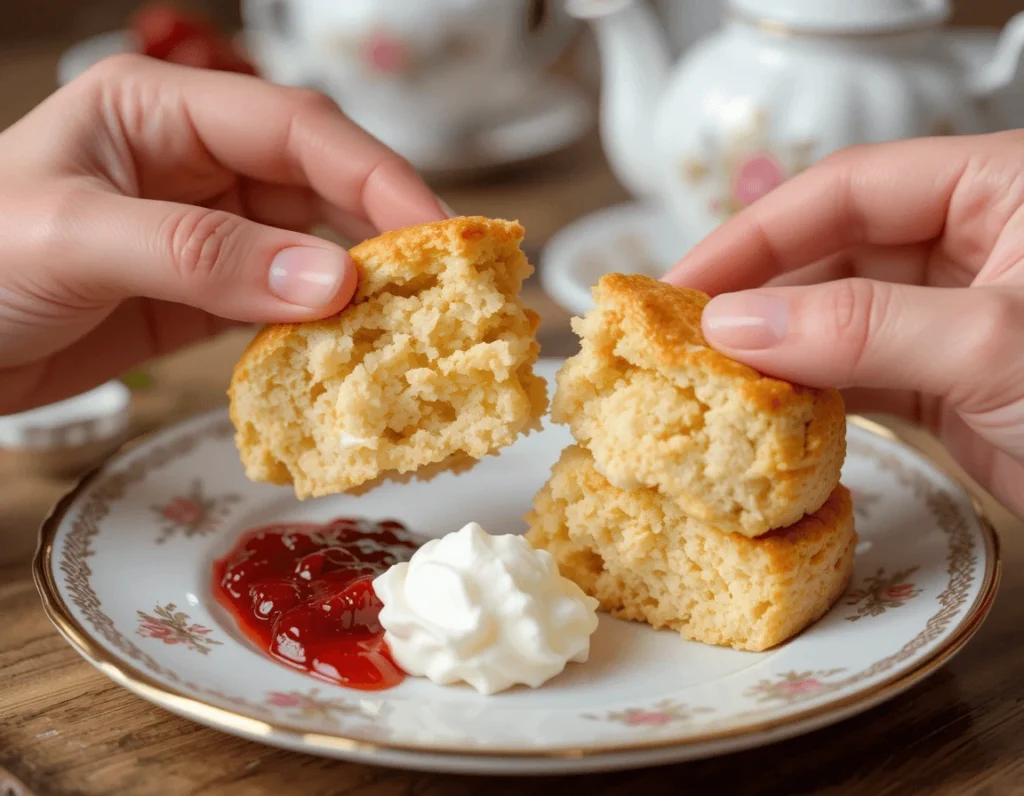
How to Eat Scones for Afternoon Tea
The Traditional Way to Enjoy Scones
Traditionally, scones should be broken in half, not cut with a knife. Once broken, they are then topped with jam and cream. Here’s the correct way to eat scones:
| Step | Action |
|---|---|
| Step 1 | Break the scone gently in half (do not cut it) |
| Step 2 | Spread a layer of jam (strawberry, raspberry, or other) |
| Step 3 | Add a dollop of clotted cream on top of the jam |
Learn more about Afternoon Tea Recipes
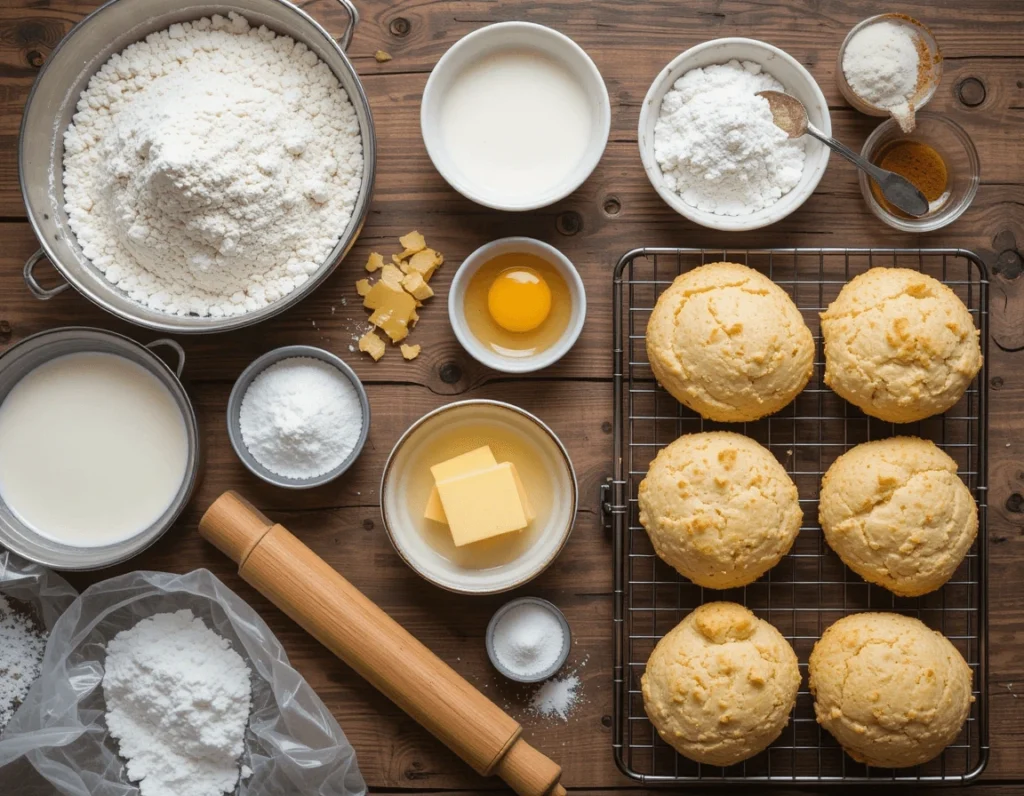
Baking Your Own Afternoon Tea Scones
The Essential Ingredients for Scones
Making scones from scratch is easy, and with a few simple ingredients, you can create a batch of delicious, tender scones. Here’s the basic list of ingredients for classic scones:
| Ingredient | Quantity |
|---|---|
| All-purpose flour | 2 cups |
| Baking powder | 1 tablespoon |
| Sugar | 1/4 cup |
| Salt | 1/2 teaspoon |
| Cold butter | 1/2 cup |
| Milk | 2/3 cup |
| Egg (for egg wash) | 1 egg |
Storing and Serving Scones
How to Keep Scones Fresh for Tea Time
Scones are best enjoyed fresh, but they can be stored for later use. Here are some options for keeping them fresh:
| Storage Method | Best For | Storage Time |
|---|---|---|
| Room Temperature | Freshly baked scones for 1-2 hours | 1-2 hours |
| Freezer | Pre-baked or unbaked scones for long-term storage | 1-3 months |
| Refrigerator | Keep scones fresh for a few days | 2-3 days |
Different Varieties of Afternoon Tea Scones
Sweet vs. Savory Scones
There’s no limit to the variety of scones you can serve. From sweet fruit scones to savory cheese scones, the possibilities are endless.
| Type of Scone | Flavor | Ideal Pairing |
|---|---|---|
| Fruit Scones | Sweet, with dried fruits like raisins or currants | Ideal with clotted cream and jam |
| Cheese Scones | Savory, often with cheddar or parmesan | Pair with smoked salmon or ham |
| Herb Scones | Savory, with rosemary, thyme, or chives | Perfect with butter or a creamy dip |
Check out our guide to Traditional Tea Party Foods
FAQ About Afternoon Tea Scones
Afternoon tea scones are a beloved treat, and it’s common to have a few questions about them. Whether you’re hosting your own tea party or simply enjoying a cozy afternoon, these FAQs will help you master the art of making and serving afternoon tea scones.
1. What is the difference between a scone and a biscuit?
Scones and biscuits are often confused, but there are key differences between the two. While both are quick breads, scones are typically sweeter and denser, often served with clotted cream and jam during afternoon tea. Biscuits, particularly in American cuisine, are usually lighter, fluffier, and less sweet, commonly served with savory dishes like gravy or fried chicken.
2. Can I make scones in advance?
Yes, you can prepare afternoon tea scones ahead of time. You can make the dough, shape the scones, and then freeze them. When you’re ready to bake, simply pop them in the oven straight from the freezer (you may need to add a few minutes to the baking time). This method ensures that you have freshly baked afternoon tea scones ready for your tea party, without the last-minute rush.
3. Can I freeze scones?
Absolutely! Scones freeze very well, either before or after baking. If freezing before baking, just shape the scones and place them on a baking sheet, then freeze. Once frozen solid, transfer them to a zip-top bag or airtight container. When you’re ready to bake, no need to thaw them—just bake them directly from the freezer. For baked afternoon tea scones, allow them to cool completely before freezing. Reheat them in the oven to bring them back to life.
4. What jam is best with scones?
The jam you choose depends on your personal preferences and the type of scones you’re serving. Traditional strawberry or raspberry jam is a popular choice for fruit scones. For more adventurous palates, you can try apricot, fig, or even marmalade. If you’re serving savory scones (like cheese scones), chutneys or savory spreads can work well instead of sweet jams.
5. How should I store leftover scones?
If you have any leftover afternoon tea scones, they can be stored in an airtight container at room temperature for up to 2-3 days. To keep them fresh, you can also wrap them tightly in foil or plastic wrap. For longer storage, freezing is the best option. Just remember to let the scones cool completely before wrapping and storing them.
6. How do I know if my scones are done baking?
Scones are done when they are golden brown on top and firm to the touch. You can also check the internal temperature using a kitchen thermometer; it should be around 200°F (93°C). If you’re uncertain, you can also use the “toothpick test”—insert a toothpick into the center of a scone; if it comes out clean, your scones are ready.
7. Can I make scones without dairy?
Yes, dairy-free scones are possible! You can substitute butter with a dairy-free margarine or coconut oil, and use almond milk, soy milk, or oat milk instead of cow’s milk. For a bit of richness, you can also use dairy-free yogurt or a plant-based cream. These substitutions will create soft, flaky afternoon tea scones that are just as delicious as the traditional version.
8. What is the best way to serve scones for afternoon tea?
The best way to serve afternoon tea scones is to present them fresh from the oven, still warm if possible. Arrange them on a tiered tray or a serving plate alongside clotted cream, jam, and tea. Be sure to break the scones (not cut them) and offer a variety of jams and creams for guests to choose from. A selection of teas should be served alongside, allowing each guest to find their perfect pairing.
9. How can I make my scones lighter and fluffier?
To make your afternoon tea scones lighter, ensure that you don’t overmix the dough. Gently fold the ingredients together until just combined to avoid dense scones. Also, make sure that your baking powder is fresh, as expired leavening agents will not give your scones the rise they need. Using cold butter and not overworking the dough also helps in achieving a light, flaky texture.
10. Are there variations to the traditional scone recipe?
Yes! Afternoon tea scones are very versatile and can be made in various flavors. Common variations include:
Fruit Scones: Add dried fruits like raisins, currants, or cranberries.
Cheese Scones: Incorporate cheese into the dough for a savory version, perfect for pairing with soups or salads.
Herb Scones: Add fresh herbs like rosemary, thyme, or chives for a savory twist.
Spiced Scones: Use spices like cinnamon, nutmeg, or ginger for a warming, flavorful scone.
Discover great ideas like Delicious Jam Pairings for Scones
Conclusion:
Afternoon tea scones are more than just a baked good—they are an integral part of a tradition that brings people together and creates unforgettable moments. With their flaky texture, rich flavor, and versatility, afternoon tea scones can easily be customized to suit any occasion. Whether you prefer them sweet, like classic fruit scones, or savory, such as cheesy or herb-infused varieties, afternoon tea scones are the perfect accompaniment to your afternoon tea.
From traditional clotted cream to whipped cream, jam, and even more adventurous spreads, the endless pairing options add to the joy of enjoying afternoon tea scones. You can also elevate the experience by pairing them with a variety of teas, such as Earl Grey, Darjeeling, or a robust English Breakfast. The delightful balance of flavors ensures that afternoon tea scones are always the star of your tea table.
But it’s not just about the taste—afternoon tea scones are also a beautiful tradition, evoking feelings of elegance and warmth. Whether you’re hosting a sophisticated tea party, celebrating a special occasion, or simply treating yourself to a peaceful moment with a cup of tea, afternoon tea scones will always be the center of attention.
Now that you have all the tips, tricks, and answers to common questions, you’re fully prepared to bake, serve, and enjoy these delightful afternoon tea scones. With your new knowledge of portion sizes, cream options, ideal pairings, and etiquette, you’re ready to host a tea gathering that will leave your guests impressed and satisfied.
So go ahead, gather your ingredients, preheat your oven, and get ready to enjoy the delightful world of afternoon tea scones. Whether it’s the first time you’re making them or you’re a seasoned baker, there’s no better time to indulge in these warm, delicious creations. Here’s to many more tea parties filled with laughter, joy, and, of course, perfect afternoon tea scones!

